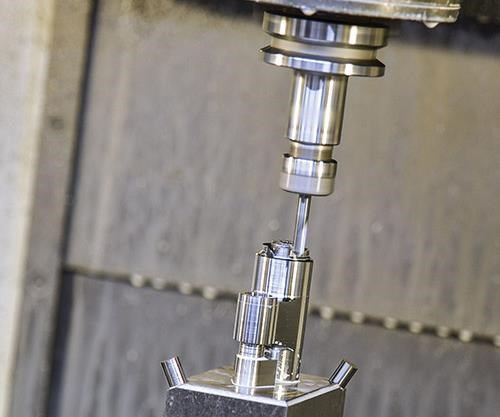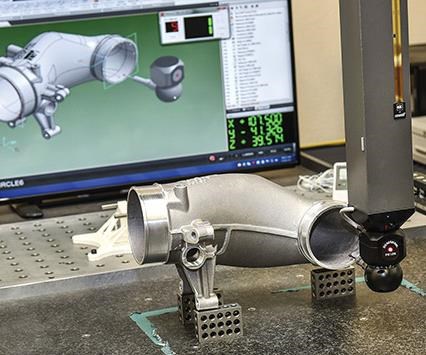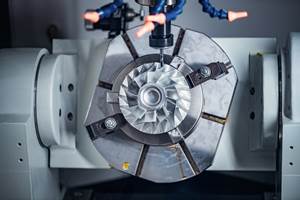Making the Move to Five-Axis
After the recession, Vineburg Machining Inc. started taking on challenging medical work, which meant taking up five-axis machining. Machinery from Haas helped cut scrap, reduce processing time and improve quality.
As the business climate began to change around the year 2000, Vineburg Machining Inc. was at a tipping point. Its customers were sending work to China to save money, and owner Gerd Poppinga knew he had to take drastic measures to reduce costs. He packed up his shop, and moved operations and willing employees from California to Lyon County, Nevada, where the tax rates were lower and the cost of living was more affordable. Of course, there was more to the move than a new address. Mr. Poppinga also challenged his employees to change their high-volume mindsets and pursue more challenging manufacturing applications. By adding five-axis capabilities from Haas Automation Inc. (Oxnard, California), the company was able to take on medical work.
Vineburg’s history is one of adaptation. Soon after Mr. Poppinga and four investors bought an Acme-Gridley machine shop that was closing its doors, he began looking for alternatives to cam-driven machines. In the mid-1980s, he purchased several used NC machines and eventually a CNC lathe. By 1997, the other partners had left the company, and Mr. Poppinga grew the business. However, when the recession hit, the shop was asked to lower its prices, and high-volume work started to dwindle. That’s when Mr. Poppinga decided to pursue more challenging work with customers who wouldn’t “beat him up for a nickel per part.” Screw machine work would remain as a steady portion of the shop’s income, but CNC was the future.
That future began to coalesce when Vineburg purchased its first Haas machining center, a VF-3SS, to which it added a TR160 trunnion for five-axis machining capability. General Manager Sven Klatt had been struggling with high scrap rates on a difficult medical part, and the ability to machine multiple sides of the workpiece in a single operation brought immediate benefits. “The new machine eliminated setups and allowed us to run complex parts in a much more efficient manner,” he says.
Happy with the performance of its first machine, and seeing potential to run similar jobs, Vineburg decided to purchase a second trunnion-equipped Haas VF-3SS a few months later. With this acquisition, the company found it could eliminate additional operations on a tool-steel part, one that was previously rough-machined before being heat-treated to 63 Rc. By cutting the part in its hardened state, the company reduced processing time and increased quality.
“Things really started to snowball from there,” Mr. Klatt explains. “Mr. Poppinga and I both came to the same conclusion: If we wanted to get into major-league machining, we had to do it right, and Haas was a big part of that. We’re a 24/7 shop, and the maintenance technician won’t hesitate to come in nights, weekends or do whatever it takes to keep us running.”
Vineburg says it also tries to go the extra mile for its customers. For example, a customer from the UK needed custom muzzle brakes for an AR-style gun machined from 4140 material in two weeks. This was no small feat, as the part’s overall features are very complicated. After receiving the CAD drawing, Mr. Klatt worked the weekend, and the shop was able to deliver the parts as promised. Two years later, Vineburg is still making 2,000 of the parts each month.
Today, the shop has 32 employees and 18,000 square feet of manufacturing space. The single Haas machine has been joined by nine others, with the most recent addition being a UMC-750SS. Three of the machines are UMC-750 machining centers, which Mr. Poppinga and Mr. Klatt first saw at an EMO machine tool exhibition in Hannover, Germany. Right away, the machine proved to be a game changer for the small but growing shop. The affordable five-axis milling machine enabled the shop to evaluate the type of work it was taking on along with its production methods. “It afforded us the ability to offer complex machining to existing and new clients, making us more profitable,” Mr. Poppinga says.
When the UMC-750 arrived, Mr. Klatt ran some parts for the foundry up the street from the shop. It was enough work to book the machine solid. Within one week of receiving the first UMC-750, Vineburg ordered another. Similar experiences drove Vineburg to order additional machines. In fact, one such job was a prosthetic knee component made of cobalt chrome alloy. Prior to the UMC-750’s arrival, Mr. Klatt and his team were making the part in eight operations and suffering 30 percent fallout due to scrap. They retooled the job for the new machine and are now making the knee implant in two operations—turning and milling—with virtually no scrap, he says. Moreover, the move cut 15 minutes off the cycle time.
Another part, this one a component for a military program, is made from 8620 alloy steel that is later induction-heat-treated. Vineburg was having quality problems with distortion from the heat-treating, so it decided to simply finish-machine the parts after hardening. “The Haas had no problem cutting the steel, even at 48 Rc, Mr. Klatt says. This is due to the machine’s rigidity, five-axis table and continuous five-axis movement. “We completely eliminated the quality issues. It seems like every time a machine comes in, it gets filled up before the tech finishes installing it,” he says. “People find out we have this capability, and the phone starts to ring. We’ve been lucky.”
Related Content
Which Approach to Automation Fits Your CNC Machine Tool?
Choosing the right automation to pair with a CNC machine tool cell means weighing various factors, as this fabrication business has learned well.
Read MoreWhy Go Five-Axis: Machine Types and Benefits
Even as the benefits of five-axis machining stack up year by year, the barrier for entry crumbles.
Read MoreFearless Five-Axis Programming Fosters Shop Growth
Reinvestment in automation has spurred KCS Advanced Machining Service’s growth from prototyping to low-and mid-volume parts. The key to its success? A young staff of talented programmers.
Read MoreCNC Machine Shop Honored for Automation, Machine Monitoring
From cobots to machine monitoring, this Top Shop honoree shows that machining technology is about more than the machine tool.
Read MoreRead Next
The Cut Scene: The Finer Details of Large-Format Machining
Small details and features can have an outsized impact on large parts, such as Barbco’s collapsible utility drill head.
Read More3 Mistakes That Cause CNC Programs to Fail
Despite enhancements to manufacturing technology, there are still issues today that can cause programs to fail. These failures can cause lost time, scrapped parts, damaged machines and even injured operators.
Read More










.jpg;maxWidth=300;quality=90)


















